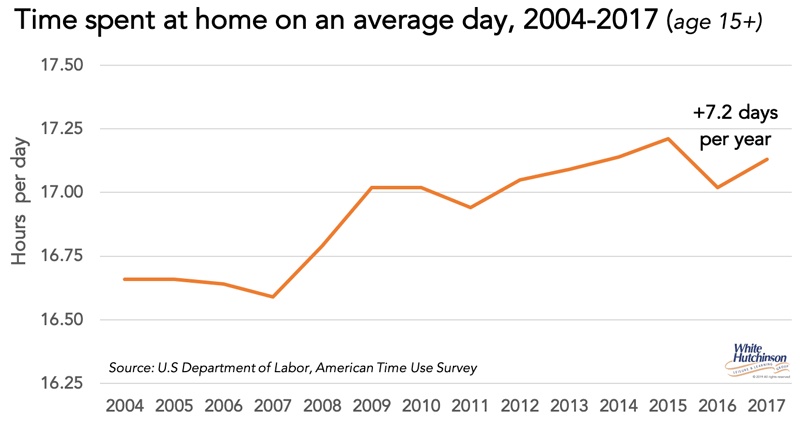
Vol. XIX, No. 7, August 2019
- Editor's corner
- Attention spans are shortening; trends don't last as long
- The evolution of the FEC industry - over expansion and opportunity
- Big investment in immersive mixed-use entertainment by Kevin Williams
- The cannibals are eating the CLV industry
- Essentials of hayride safety
- Is the obsession with beer justified?
- Review of Bar K - a multispecies social eatertainment venue by Linda Beckring
- The importance of great restaurant ambiance
- Do you know your cost of goods sold percentage?
- Jim Kessler gives it to us straight
- Cathedral-tainment
- Home is the new hangout
- Out-of-home entertainment & arts spending by occupation
- Randy's travel tips
Home is the new hangout
We've previously reported on the negative impact of people spending more time at home on out-of-home entertainment, often referred to by such terms as home-basing, cocooning, bunkering and digital hiving. Home has become the sanctuary where technology has enabled people to access almost all their needs.
We decided to dig into the American Time Use Survey data to determine if this trend is true and to what extent. Here's the results:

Compared to 2004, Americans age 15+ on average now spend almost one-half hour (28 minutes) more time at home each day. That's the equivalent of 7 days - 3.5 hours more time a year at home than in 2004.
Of the less time spent out-of-home each year, 7.3 hours of it was for less time spent traveling to and from and at entertainment and art venues. Assuming around 2.5 hours per visit, that means that in 2017, the average American age 15+ made three less visits to eatertainment and art venues than in 2004.
Although this is not good news for brick-and-mortar retail and out-of-home entertainment, it does have one good benefit. Researchers have identified a positive trade-off for the rise in online shopping, our consumption of streaming video, and employees working from home. Despite increasing the amount of residential energy demand, the decrease in travel and use of non-residential spaces is responsible for a net savings of 1,600 trillion BTU in energy for the United States, approximately 1.7% of all national energy use.
Additional reading about the staying at home trend:
- Home-basing - the new competition
- Staying in is the new going out; welcome to Generation Homebody
- Cocooning is the NEW going out: the hygge trend's impact on CLVs
- Bunkering; cocooning goes extreme
- The rise of super Digital Hiving
Vol. XIX, No. 7, August 2019
- Editor's corner
- Attention spans are shortening; trends don't last as long
- The evolution of the FEC industry - over expansion and opportunity
- Big investment in immersive mixed-use entertainment by Kevin Williams
- The cannibals are eating the CLV industry
- Essentials of hayride safety
- Is the obsession with beer justified?
- Review of Bar K - a multispecies social eatertainment venue by Linda Beckring
- The importance of great restaurant ambiance
- Do you know your cost of goods sold percentage?
- Jim Kessler gives it to us straight
- Cathedral-tainment
- Home is the new hangout
- Out-of-home entertainment & arts spending by occupation
- Randy's travel tips


